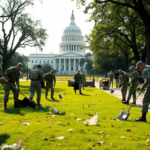Table of Contents
The evolving role of the military in immigration enforcement is stirring up quite a debate. What does this mean for national security and our civil liberties? Recently, Defense Secretary Pete Hegseth faced some tough questions from Senator Jack Reed during a Senate Appropriations Committee meeting.
Reed wasn’t shy about criticizing the decision to send Marines to Los Angeles amid protests against ICE. Let’s take a closer look at these deployments and what they signify for U.S. immigration policy.
Marines on the Move
Right now, around 200 Marines are mobilized in Florida, ready to assist U.S.
Immigration and Customs Enforcement (ICE) with its operations. This move comes at the request of the Department of Homeland Security (DHS) and is part of a broader strategy to beef up law enforcement capabilities across several states, including Florida, Louisiana, and Texas.
But here’s the kicker: these Marines—coming from Marine Wing Support Squadron 272 and Marine Corps Air Station New River in North Carolina—won’t be engaging in law enforcement activities. Instead, they’re focused on providing administrative and logistical support to ICE facilities.
How does this help? According to USNORTHCOM, this role is crucial for easing the workload on local law enforcement, allowing them to focus on their core responsibilities.
This deployment signals a shift towards more military support for domestic operations, especially as challenges around immigration enforcement continue to escalate.
Secretary Parnell has authorized the mobilization of 700 personnel, including active duty, National Guard, and reserve forces—an impressive commitment to this ongoing effort.
Political Reactions: A Hot Button Issue
Of course, deploying military personnel for immigration enforcement isn’t without its critics.
The decision to send a battalion of 500 Marines to Los Angeles to manage anti-immigration protests has sparked sharp backlash from various political figures, including California Governor Gavin Newsom. He called this troop movement unnecessary and even took legal action against the Trump administration as a response.
This political uproar highlights the tensions surrounding the militarization of immigration enforcement. Critics are worried that such actions could infringe upon civil liberties and heighten tensions between communities and law enforcement. On the flip side, supporters argue that military support is essential for maintaining order and upholding the rule of law, especially in light of increasing protests and unrest.
The Pentagon has defended its decision, stressing that military support aims to enhance operational control along the southern border. Defense Secretary Hegseth’s recent directive also points to the military’s role in managing federal land along the border, further expanding its footprint in this contentious area.
What It Means for the Future
The military’s involvement in immigration enforcement is part of a wider trend of growing militarization in domestic policy. The establishment of the Joint Task Force – Southern Border (JTF-SB) is a key example, consolidating military resources along the U.S.-Mexico border and integrating capabilities from both the Air Force and USNORTHCOM.
As the military takes on roles traditionally held by law enforcement, the implications for policy and governance are significant. The challenge lies in balancing national security with the protection of civil liberties. As these military operations expand into domestic territories, it’s crucial to keep the conversation going about accountability and transparency in these initiatives.
Ultimately, the military’s evolving role in immigration enforcement reflects broader societal debates about security, immigration policy, and the limits of military authority in our everyday lives. As the U.S. navigates its complex immigration landscape in the years ahead, understanding these dynamics will be more important than ever. Are we ready to tackle these issues head-on?





